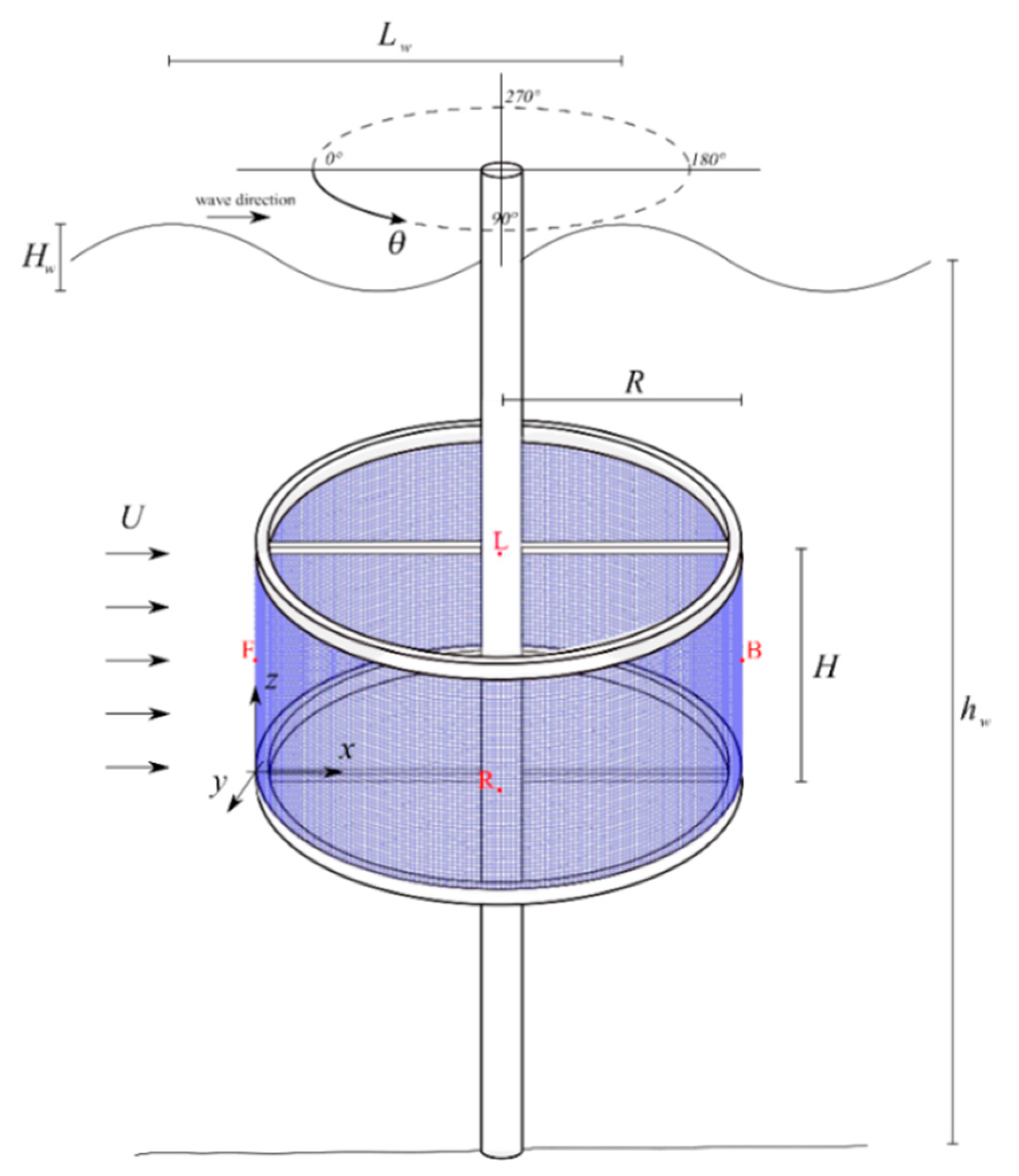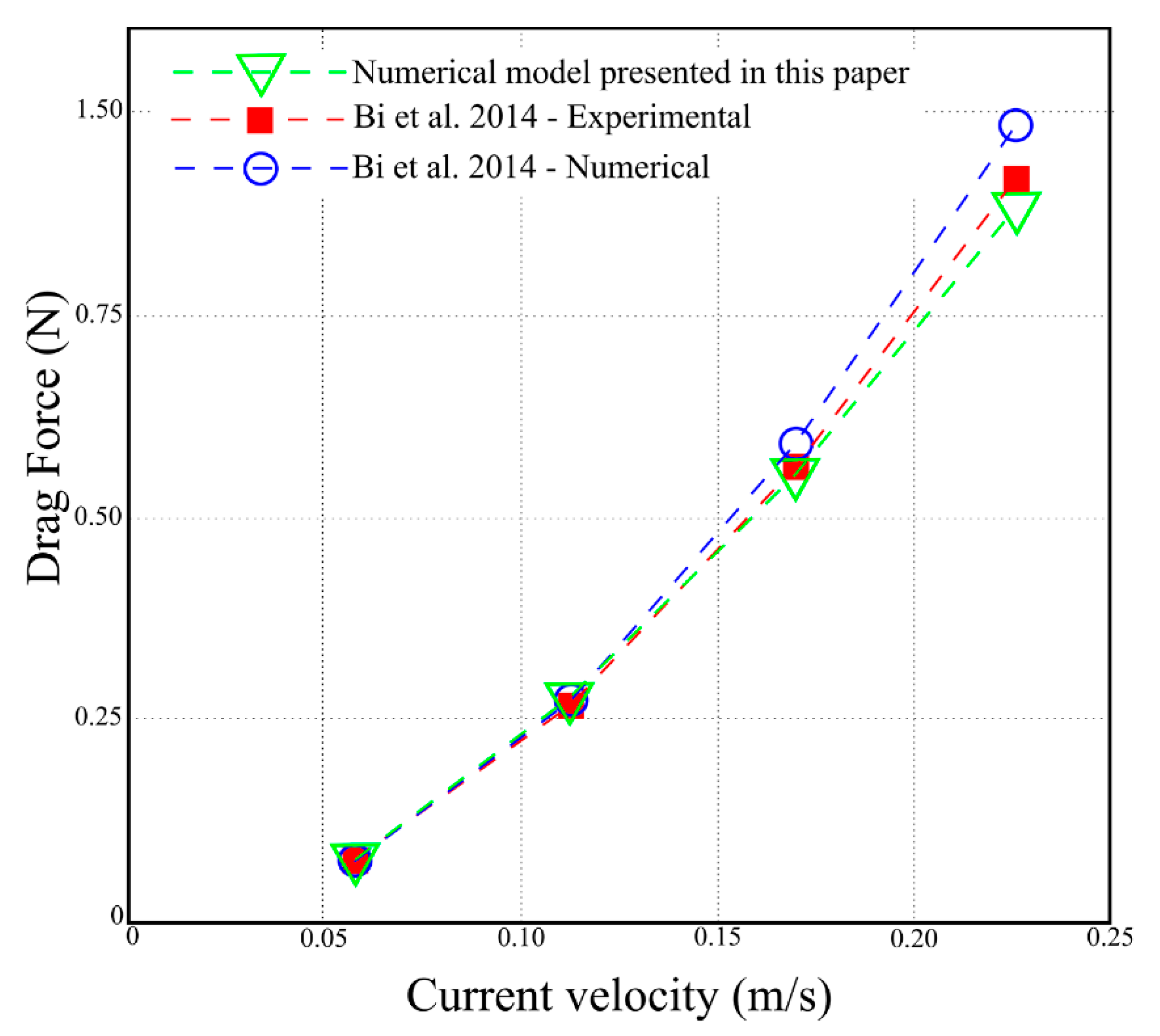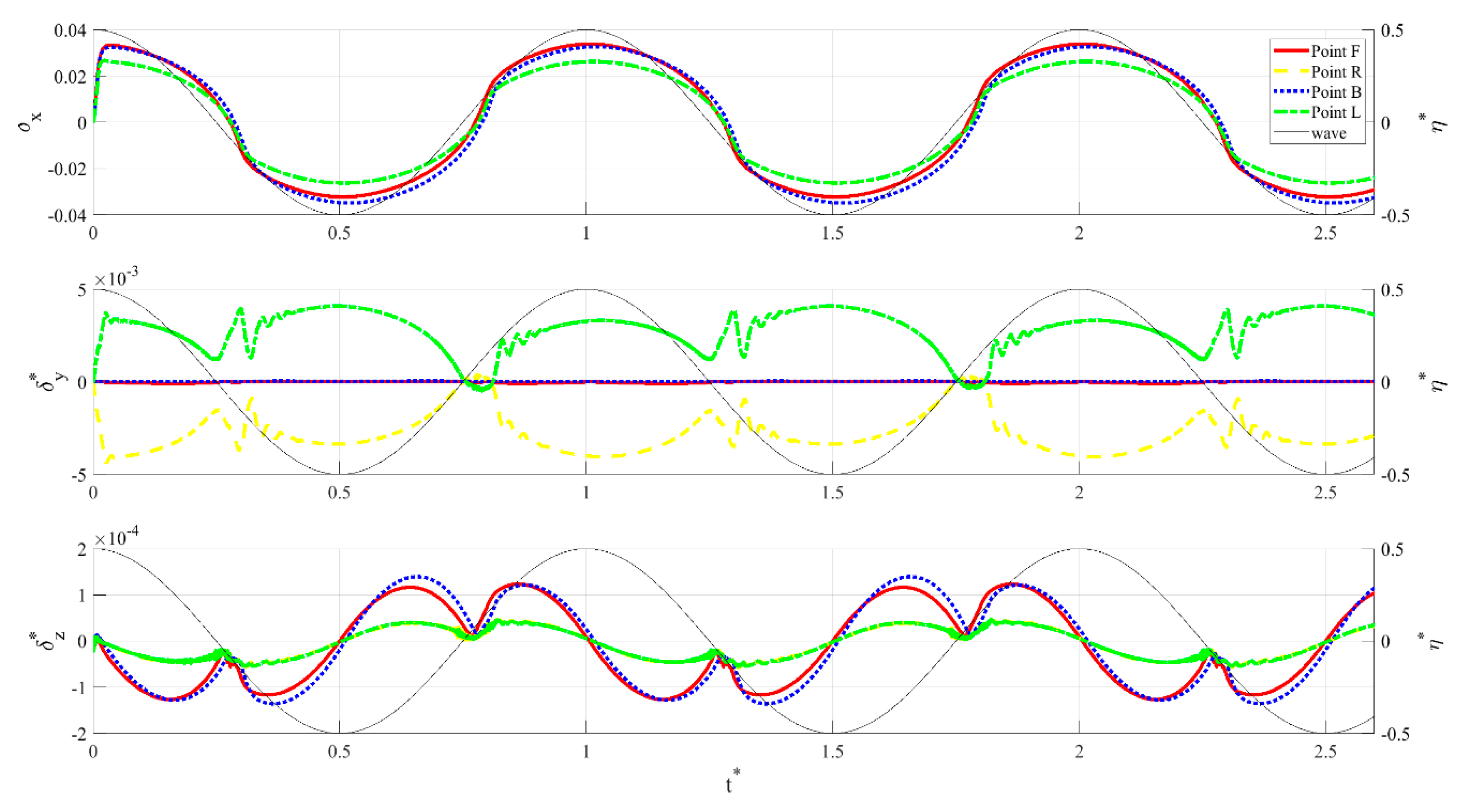Preliminary Results on the Dynamics of a Pile-Moored Fish Cage with Elastic Net in Currents and Waves
Abstract
1. Introduction
2. Methods
Validation
3. Results
3.1. Cage Dynamics in Steady Sea Currents
3.2. Cage Dynamics in Sea Waves
4. Discussion and Conclusions
Conclusions and Outlooks
- We used an accurate numerical model to describe carefully the reaction of a cylindrical pile-moored fish cage in sea currents and waves, representative for a possible application in the overall re-use strategy of an offshore platform foundation.
- We investigated the response of a fish farm new with respect to those treated so far in the sector, represented by a net cage fixed at the top and at the bottom, to two rigid rings).
- Simulations show expected major displacements of the frontal and back points of the net in the sea current and wave direction (at crest and trough stages), while unexpected displacements of the lateral points have been found in the crossflow direction, toward the center of the net.
- Beyond evaluating the significant parameters of the net displacement, the numerical model can also provide an accurate description of the distribution of deformation and tension in space and a more detailed description of the complex changes in shape of the net.
- In the future, a grouping method will be implemented in the numerical model, for the study of realistic pile-moored fish cage forced by realistic sea states.
Author Contributions
Funding
Institutional Review Board Statement
Informed Consent Statement
Data Availability Statement
Conflicts of Interest
References
- FAO. FAO Yearbook of Fishery and Aquaculture Statistics 2015; FAO: Rome, Italy, 2017. [Google Scholar]
- Klebert, P.; Lader, P.; Gansel, L.C.; Oppedal, F. Hydrodynamic interactions on net panel and aquaculture fish cages: A review. Ocean Eng. 2013, 58, 260–274. [Google Scholar] [CrossRef]
- Lader, P.; Fredheim, A. Dynamic properties of a flexible net sheet in waves and current—A numerical approach. Aquac. Eng. 2006, 35, 228–238. [Google Scholar] [CrossRef]
- Tsukrov, I.; Drach, A.; Decew, J.; Swift, M.; Celikkol, B. Characterization of geometry and normal drag coefficients of copper nets. Ocean Eng. 2011, 38, 1979–1988. [Google Scholar] [CrossRef]
- Tsukrov, I.; Eroshkin, O.; Fredriksson, D.; Swift, M.; Celikkol, B. Finite element modeling of net panels using a consistent net element. Ocean Eng. 2003, 30, 251–270. [Google Scholar] [CrossRef]
- Li, Y.-C.; Zhao, Y.; Gui, F.-K.; Teng, B. Numerical simulation of the hydrodynamic behaviour of submerged plane nets in current. Ocean Eng. 2006, 33, 2352–2368. [Google Scholar] [CrossRef]
- Zhao, Y.-P.; Li, Y.-C.; Dong, G.-H.; Gui, F.-K.; Teng, B. Numerical simulation of the e_ects of structure size ratio and mesh type on three-dimensional deformation of the fishing-net gravity cage in current. Aquac. Eng. 2007, 36, 285–301. [Google Scholar] [CrossRef]
- Dong, G.-H.; Xu, T.-J.; Zhao, Y.-P.; Li, Y.-C.; Gui, F.-K. Numerical simulation of hydrodynamic behavior of gravity cage in irregular waves. Aquac. Eng. 2010, 42, 90–101. [Google Scholar] [CrossRef]
- Xu, T.-J.; Dong, G.-H.; Zhao, Y.-P.; Li, Y.-C.; Gui, F.-K. Analysis of hydrodynamic behaviors of gravity net cage in irregular waves. Ocean Eng. 2011, 38, 1545–1554. [Google Scholar] [CrossRef]
- Chen, C.-P.; Zhao, Y.; Li, Y.-C.; Dong, G.-H.; Zheng, Y.-N. Numerical analysis of hydrodynamic behaviors of two net cages with grid mooring system under wave action. China Ocean Eng. 2012, 26, 59–76. [Google Scholar] [CrossRef]
- Zhao, Y.-P.; Gui, F.-K.; Xu, T.-J.; Chen, X.-F.; Cui, Y. Numerical analysis of dynamic behavior of a box-shaped net cage in pure waves and current. Appl. Ocean Res. 2013, 39, 158–167. [Google Scholar] [CrossRef]
- Xu, T.-J.; Zhao, Y.-P.; Dong, G.-H.; Li, Y.-C.; Gui, F.-K. Analysis of hydrodynamic behaviors of multiple net cages in combined wave–current flow. J. Fluids Struct. 2013, 39, 222–236. [Google Scholar] [CrossRef]
- Cui, Y.; Guan, C.-T.; Wan, R.; Huang, B.; Li, J. Numerical simulation of a flatfish cage system in waves and currents. Aquac. Eng. 2013, 56, 26–33. [Google Scholar] [CrossRef]
- Huang, X.-H.; Guo, G.-X.; Tao, Q.-Y.; Hu, Y.; Liu, H.-Y.; Wang, S.-M.; Hao, S.-H. Dynamic deformation of the floating collar of a net cage under the combined e_ect of waves and current. Aquac. Eng. 2018, 83, 47–56. [Google Scholar] [CrossRef]
- Huang, X.; Liu, H.; Tao, Q.; Hu, Y.; Wang, S.; Yuan, T. Numerical analysis of the dynamic response of a single-point mooring fish cage in waves and currents. Aquac. Stud. 2019, 19, 25–35. [Google Scholar] [CrossRef]
- Le Bris, F.; Marichal, D. Numerical and experimental study of submerged supple nets: Applications to fish farms. J. Mar. Sci. Technol. 1998, 3, 161–170. [Google Scholar] [CrossRef]
- Kristiansen, T.; Faltinsen, O.M. Modelling of current loads on aquaculture net cages. J. Fluids Struct. 2012, 34, 218–235. [Google Scholar] [CrossRef]
- Kristiansen, T.; Faltinsen, O.M. Experimental and numerical study of an aquaculture net cage with floater in waves and current. J. Fluids Struct. 2015, 54, 1–26. [Google Scholar] [CrossRef]
- Lader, P.; Fredheim, A. Modeling of net structures exposed to 3d waves and current. In Proceedings of the Open Ocean Aquaculture IV Symposium., Saint Andrews, NB, Canada, 17–20 June 2001. [Google Scholar]
- Lader, P.; Fredheim, A.; Lien, E. Dynamic behavior of 3d nets exposed to waves and current. In Proceedings of the 20th International Conference on Offshore Mechanics and Arctic Engineering, Rio de Janeiro, Brazil, 3–8 June 2001. [Google Scholar]
- Lader, P.F.; Enerhaug, B.; Fredheim, A.; Johnsen, S.G.; Krokstad, J.R. Hydroelastic Modelling of Net Structures Exposed to Waves and Current. Available online: https://www.sintef.no/globalassets/upload/fiskeri_og_havbruk/havbruksteknologi/intellistruct/lader2003_hydmodnet_nmc.pdf (accessed on 23 December 2020).
- Klebert, P.; Patursson, Ø.; Endresen, P.C.; Rundtop, P.; Birkevold, J.; Rasmussen, H.W. Three-dimensional deformation of a large circular flexible sea cage in high currents: Field experiment and modeling. Ocean Eng. 2015, 104, 511–520. [Google Scholar] [CrossRef]
- Lee, C.-W.; Kim, Y.-B.; Lee, G.-H.; Choe, M.-Y.; Lee, M.-K.; Koo, K.-Y. Dynamic simulation of a fish cage system subjected to currents and waves. Ocean Eng. 2008, 35, 1521–1532. [Google Scholar] [CrossRef]
- Lee, C.W.; Lee, J.; Park, S. Dynamic behavior and deformation analysis of the fish cage system using mass-spring model. China Ocean Eng. 2015, 29, 311–324. [Google Scholar] [CrossRef]
- Decew, J.; Tsukrov, I.; Risso, A.; Swift, M.; Celikkol, B. Modeling of dynamic behavior of a single-point moored submersible fish cage under currents. Aquac. Eng. 2010, 43, 38–45. [Google Scholar] [CrossRef]
- Li, L.; Fu, S.; Xu, Y. Nonlinear hydroelastic analysis of an aquaculture fish cage in irregular waves. Mar. Struct. 2013, 34, 56–73. [Google Scholar] [CrossRef]
- Li, L.; Fu, S.; Xu, Y.; Wang, J.; Yang, J. Dynamic responses of floating fish cage in waves and current. Ocean Eng. 2013, 72, 297–303. [Google Scholar] [CrossRef]
- Føre, H.M.; Endresen, P.C.; Aarsæther, K.G.; Jensen, J.H.; Føre, M.; Kristiansen, D.; Fredheim, A.; Lader, P.; Reite, K.-J. Structural Analysis of Aquaculture Nets: Comparison and Validation of Different Numerical Modeling Approaches. J. Offshore Mech. Arct. Eng. 2015, 137, 041201. [Google Scholar] [CrossRef]
- Bi, C.-W.; Zhao, Y.-P.; Dong, G.-H.; Xu, T.-J.; Gui, F.-K. Numerical simulation of the interaction between flow and flexible nets. J. Fluids Struct. 2014, 45, 180–201. [Google Scholar] [CrossRef]




| t* | (m 10−3) | t* | (m 10−3) | t* | ||
| F | 0.034 | 1.00 | 2.708 | 0.44 | 123.340 | 0.86 |
| B | 0.033 | 1.01 | 47.298 | 0.67 | 139.640 | 0.65 |
| L | 0.026 | 1.01 | 4085.900 | 0.49 | 45.534 | 0.81 |
| R | 0.026 | 1.01 | 370.190 | 0.77 | 47.086 | 0.82 |
| t* | (m 10−3) | t* | (m 10−3) | t* | ||
| F | −0.032 | 0.503 | −0.084 | 0.164 | −0.126 | 1.147 |
| B | −0.035 | 0.516 | −0.012 | 0.782 | −0.136 | 0.363 |
| L | −0.026 | 0.505 | −0.488 | 0.783 | −0.055 | 0.323 |
| R | −0.026 | 0.505 | −4.043 | 1.027 | −0.056 | 0.308 |
| 1st 0-DC | 1st 0-UC | 2nd 0-DC | 2nd 0-UC | 3rd 0-DC | |
|---|---|---|---|---|---|
| t*(η = 0) | 0.250 | 0.750 | 1.250 | 1.750 | 2.250 |
| t*(= 0) in F | 0.278 | 0.775 | 1.278 | 1.775 | 2.278 |
| delay for F | 0.028 | 0.025 | 0.028 | 0.025 | 0.028 |
| t*(= 0) in B | 0.287 | 0.789 | 1.287 | 1.789 | 2.287 |
| delay for B | 0.037 | 0.039 | 0.037 | 0.039 | 0.037 |
| t*(= 0) in L | 0.279 | 0.781 | 1.279 | 1.782 | 2.279 |
| delay for L | 0.029 | 0.031 | 0.029 | 0.032 | 0.029 |
| t*( = 0) in R | 0.279 | 0.781 | 1.279 | 1.782 | 2.279 |
| delay for R | 0.029 | 0.031 | 0.029 | 0.032 | 0.029 |
Publisher’s Note: MDPI stays neutral with regard to jurisdictional claims in published maps and institutional affiliations. |
© 2020 by the authors. Licensee MDPI, Basel, Switzerland. This article is an open access article distributed under the terms and conditions of the Creative Commons Attribution (CC BY) license (http://creativecommons.org/licenses/by/4.0/).
Share and Cite
Zitti, G.; Novelli, N.; Brocchini, M. Preliminary Results on the Dynamics of a Pile-Moored Fish Cage with Elastic Net in Currents and Waves. J. Mar. Sci. Eng. 2021, 9, 14. https://doi.org/10.3390/jmse9010014
Zitti G, Novelli N, Brocchini M. Preliminary Results on the Dynamics of a Pile-Moored Fish Cage with Elastic Net in Currents and Waves. Journal of Marine Science and Engineering. 2021; 9(1):14. https://doi.org/10.3390/jmse9010014
Chicago/Turabian StyleZitti, Gianluca, Nico Novelli, and Maurizio Brocchini. 2021. "Preliminary Results on the Dynamics of a Pile-Moored Fish Cage with Elastic Net in Currents and Waves" Journal of Marine Science and Engineering 9, no. 1: 14. https://doi.org/10.3390/jmse9010014
APA StyleZitti, G., Novelli, N., & Brocchini, M. (2021). Preliminary Results on the Dynamics of a Pile-Moored Fish Cage with Elastic Net in Currents and Waves. Journal of Marine Science and Engineering, 9(1), 14. https://doi.org/10.3390/jmse9010014







